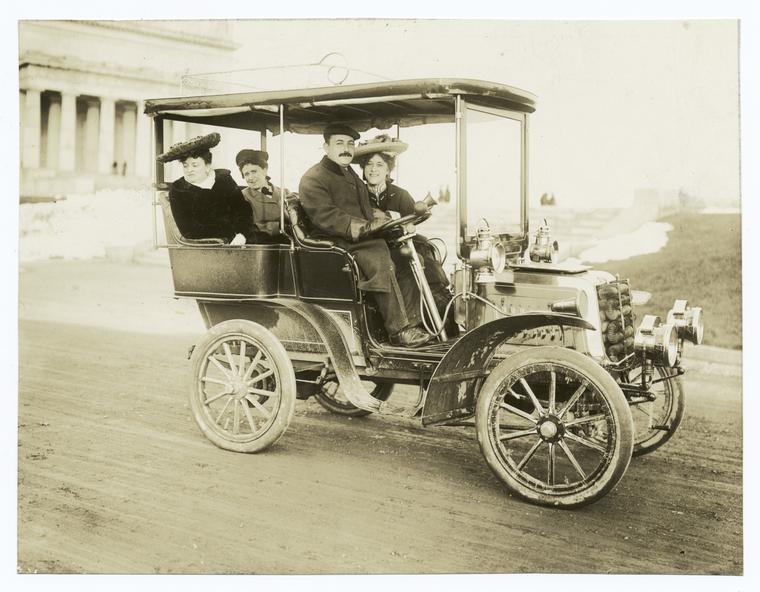Biblio File
Road Trip

The explosion of automobile production in the first decade of the Twentieth Century inevitably created a curiosity and demand for places to go, and a need for the roads to get there. An increase in popular travel had been seen previously with the completion of the First Transcontinental Railroad in 1869, but in many ways the emergence of the automobile was more significant for the depth and breadth of travel it permitted. Car travel allowed for afternoon jaunts to the nearby town, as well as months of wandering, hitting every nook and cranny and tiny sidelight that had never seen the likes of a railroad. The Interstate Highway System, completed in 1956, finally cemented the ability of adventurers, poetic souls and amateur sociologists to see the country in a novel way. From the very beginning, this public brought their pencils (and pens, typewriters and laptops) and heaped their works upon the shelves here at the library.
The Milstein Division’s array of travelogues is a gem of a collection containing hundreds of volumes. Covering travel from the age of the explorers to the modern day, the collection continues to grow. Among the categories of American travel writing we hold are journals documenting Western exploration (Lewis & Clark), the travel diaries of famous authors (Mark Twain) and presidents (Theodore Roosevelt), theme-based travel (books on Route-66), and the musings of foreign nationals seeing the country for the first time (G.K. Chesterton).
For the armchair traveler interested in delving into the collection, a couple of road trip titles to pique your interest are Modern Gypsies, by Mary Crehore Bedell, and By Motor to the Golden Gate, by none other than the etiquette maven Emily Post. Modern Gypsies, published in 1924, is a description of Bedell and her husband’s 12,000-mile car-camping road trip. The map of their expedition is a doozy: their route circles the perimeter of the country. They began traveling by ship from New York south to Florida, drove across the southwest—dipping down to Mexico to visit Juarez and Tijuana—to California, up to Washington and then back along to New York, which they entered via Canada, at Niagara Falls. Along their travels they hiked a glacier, fed bears in Yellowstone (tsk, tsk), witnessed a Texas cyclone, and visited Seminole and Flathead reservations. Their photographs are engaging, capturing representatives of the American population at a time before mass-marketed fashion and culture, and in surprisingly open, relaxed poses.
Emily Post’s By Motor to the Golden Gate, published in 1916, begins with what her dinner party companions deemed a rather daring announcement: that she and her son intended to travel “in comfort” (read: in luxury) across the continent without servants or chauffeur accompanying them. Bear in mind that they were traveling at a time when cars frequently broke down—theirs made it a mere 200 miles before initially succumbing—and rest stops and lodging were considerably less frequent than they are today. Hearing that “You won’t find Ritz hotels every few miles, and you won’t find Central Park roads all the way,” did give her pause, however she decided to tackle the challenge nonetheless. And I am glad that she did: her descriptions of the people and places she encountered are delightful, her itemized list of daily expenses amusing, and she offers this beauty of an argument for travel in America:
Imagine people living all their lives in Cairo never having seen the Pyramids. Imagine anyone living in Italy never having been to Pompeii. Yet we, ourselves, to whom the antiquities and wonders of far countries are perfectly familiar, did not even know that the wonders of our Southwest existed!
Miss Post’s final answer to the question “How far can you go in comfort?” was the intriguing answer of “Pueblo, Colorado.” As a native Coloradoan, I am pleased to hear my state made the cut! For researchers interested in reading further about American road trips, I offer several helpful subject headings for use in our catalog. I also will be continuing to feature travel writing in our collections. I’d love to hear your favorites!
Subject headings:
Travel writing
Travelers’ writings, American [state or country] – Description and travel
Automobile travel—United States—History—20th century
Read E-Books with SimplyE
 With your library card, it's easier than ever to choose from more than 300,000 e-books on SimplyE, The New York Public Library's free e-reader app. Gain access to digital resources for all ages, including e-books, audiobooks, databases, and more.
With your library card, it's easier than ever to choose from more than 300,000 e-books on SimplyE, The New York Public Library's free e-reader app. Gain access to digital resources for all ages, including e-books, audiobooks, databases, and more.
If you don’t have an NYPL library card, New York State residents can apply for a digital card online or through SimplyE (available on the App Store or Google Play).
Need more help? Read our guide to using SimplyE.
Comments
Two travel writing books I
Submitted by Anonymous (not verified) on December 11, 2009 - 6:17pm
Thank you for sharing some
Submitted by Laura Ruttum on December 15, 2009 - 5:38pm